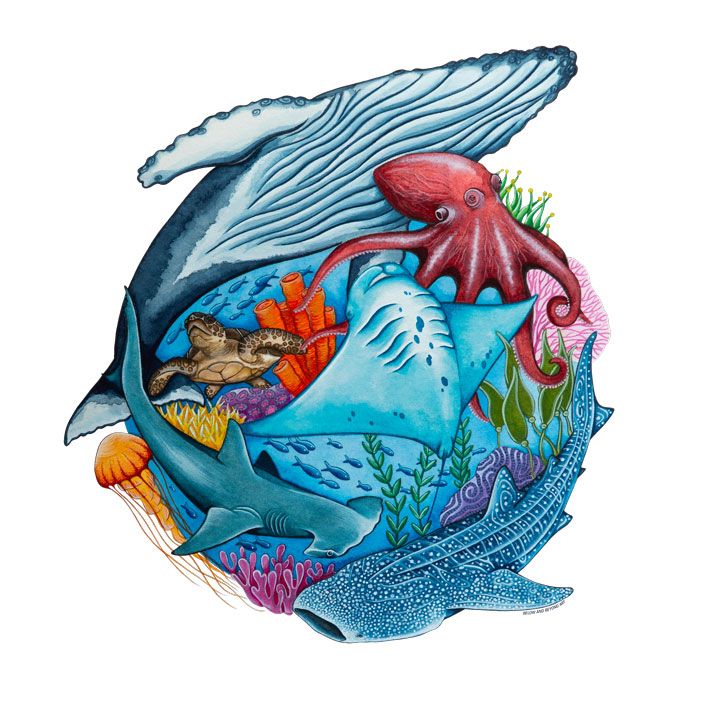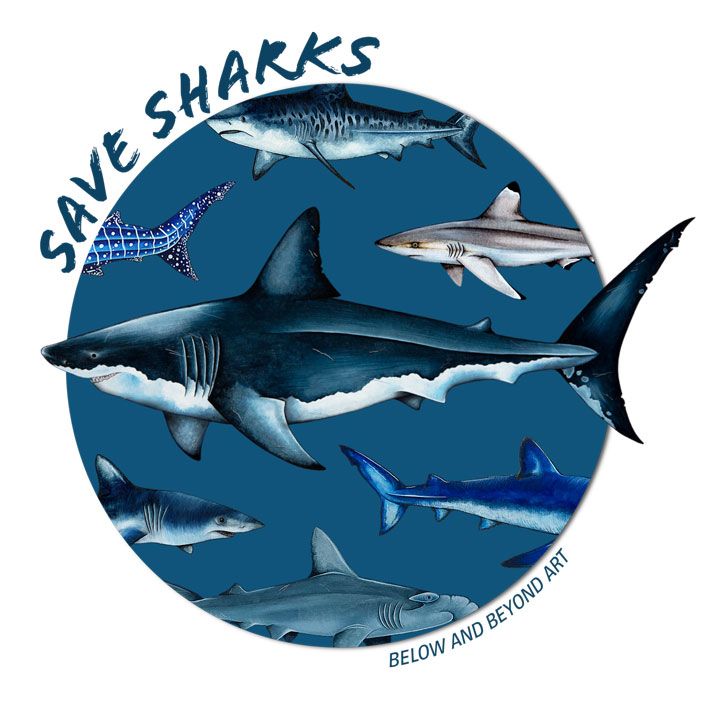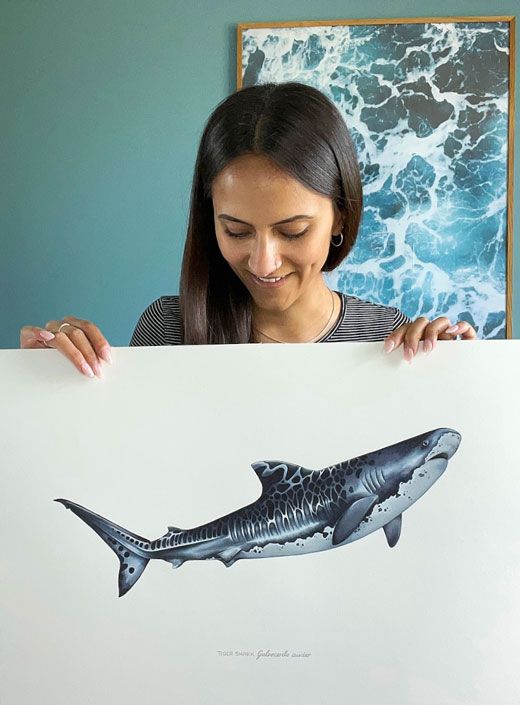In partnership with The Global Goals for #BlueToDo, an initiative raising awareness of the importance of a healthy ocean, Arts Help will publish a series of interviews highlighting artists that combine their creative minds with their passion for the United Nations Sustainable Development Goal of Life Below Water.
British ocean artist and scientific illustrator, Janavi Kramer, shares in this interview with Arts Help the life-changing encounter that made her switch professions, the mission behind her work and why it’s imperative that we all start doing our part, as small as it may seem, in protecting the ocean.
First, can you tell us a bit about yourself?
My name is Janavi Kramer and I’m the face behind Below and Beyond Art. I’m a British ocean artist and scientific illustrator, and I’m based in Hertfordshire which is quite far from any ocean. I started my career as an ocean artist about four years ago, although my previous professional background is quite different to where I am now. My background is in theatre and events, so I actually trained as a physical theatre performer and I think it really taught me the power of visual storytelling. That’s something I really carry through with me in my work today and the mission behind my work.
I hope to evoke the same passion in other people and also, more importantly, spread awareness of the threats impacting our oceans and the species within it. I try to excite people with my work, so I create highly visual, colourful and textured illustrations of different species, and also conceptual work based on some of the various threats that are impacting our ocean.

How did you get started with painting and why did you choose to focus on marine life?
I’m really lucky that I grew up with a really creative household. Both of my parents are formally trained as scientists, but my mom is [also] an artist. We have a very rugged and wild coastline here in the UK where I was really fortunate to spend a lot of my childhood, so you could always find me in rock pools, discovering new species, snorkeling in seaweed, and Mom was always trying to pull me out of the water.
As I grew up, that love and excitement turned into more of a fascination and an obsession. I was just searching for ways to immerse myself further into that, and I began scuba diving about 8 or 9 years ago. That experience took my level of understanding and my perspective of the oceanic environment and really flipped it on its head. I was just in awe of how different it is from when you see it in picture books and on the TV compared to when you’re actually in the ocean.
As well as being in awe, I also started to learn further on oceanic environment, whether that’s plastic pollution, bleaching corals or disregarded fishing gear. I think that was when I realized that I wanted to find a path in my career that actually contributed to the protection of our ocean and really had an impact on trying to save what’s left and restore it.
Do you have a favourite marine animal to paint? What about the most challenging?
Manta rays, definitely. Anyone who knows me personally knows that I’m quite obsessed with mobulas. Manta rays were the most life-changing encounter I had because they were the first big marine species that I encountered when diving. Having that amazing experience and then educating myself on them and finding out that all 10 species of mobulas are either endangered or vulnerable to extinction—that’s where it all started. That’s why it’s in my logo as well, so they’re certainly my favourite one.
My most difficult one is definitely cephalopods, so things like octopuses and squids. I find them to be the most difficult species to create because their skin texture is so complex and intricate. In some of the species, their skin patterns and textures are rather changing because they can almost morph into different surrounding environments. I sometimes worry I can’t do them justice, but it’s certainly a welcome challenge and I still love painting them.

Besides painting marine life, you also enjoy underwater activities. Can you talk about your experiences?
Getting myself in the water was that transitional thing from just loving watching Blue Planet as a kid into actually having a greater understanding of it. I’m a divemaster and I’ve been diving for about 8 or 9 years. I think diving was the moment that really shifted my perspective on the marine environment and my understanding of it. I’ve been really lucky to dive in so many places around the world over the years. It’s something that I wish that everyone could experience, but I completely understand it’s not accessible to everyone, so I think with my work I try to take people under the water with me and show them how incredibly beautiful and vibrant the world is.
Diving is such a tranquil, almost meditative state where you can go in and you just have nothing around you and all you can hear is your breath, so when I’m diving it’s kind of my time to soak up all the inspiration. I’m now working on my photography as well, so I take my camera down with me. A lot of my paintings I paint from my own reference photos.
Having said that, everywhere I have dived in the world is not without seeing some kind of human impact or the issues caused by climate change. I think diving and having that encounter with the manta ray, that was my turning point. I didn’t switch my career immediately, but it was the turning point in my mind. On my first dive in 2016 with an oceanic manta ray—the first time I had ever encountered one—, it was just the most amazing moment seeing this majestic thing come gliding over the coral, but at the same time I couldn’t help but notice in my peripheral that there was plastic floating by.
It was such a conflict of emotions because you can’t quite believe that something like this exists in the world, and yet here we are floating past because of the lack of respect and understanding we have of the ocean. I think I didn’t quite realize it yet but that’s always the moment I draw back to. It was the most shocking contrast I’d ever seen. In Indonesia, in some areas because they have no plastic pollution infrastructure, whenever there’s monsoon season all of the plastic washes into the ocean, yet they’re also famed for their incredible wildlife, so if you go slightly at the wrong time it’s a really shocking visual image to see.
Diving is definitely my window into understanding that world better. Jacques Cousteau said that if we want to experience it, “We must go see for ourselves,” and I really believe that. I think that if you can and you have the opportunity to do it, then there’s no better way than fully immersing yourself in the environment. You just gain such a greater appreciation and awareness of how fragile the ecosystem is. Something as simple as not being a responsible diver, when they’re not aware of their surroundings, if they hit a piece of coral, the detriment to that coral reef and how many years that coral has taken to grow is quite astonishing.

You often collaborate with conservation organizations. Can you talk about why that is important to you?
I completely am of the belief that every individual can make a difference. I really believe that everyone should take a look at the skills they have and see if there’s a way that they can utilize that to contribute towards conservation, and not just oceanic conservation, terrestrial is equally important in a lot of cases.
Having said that, there are so many marine organizations and charities that are working tirelessly to protect and try and get a greater understanding of what’s actually happening to the planet, what things can be put in place. Sadly, a lot of them are underfunded or they rely heavily on donations and public support. I believe that with these organizations on the front line, we should be doing what we can to support them.
As much as I want to be actively involved in conservation, I’m not a scientist, so I utilize the skills that I have to contribute. But it’s equally important to continue supporting them, so what I try to do is donate a percentage of profits from various pieces in my work and that goes directly to them. I also collaborate with different organizations to support them with their campaigns, like I did for Shark Finning EU last year; they had a huge campaign to stop the finning trade.
We have to find this harmony between art and science where we can use art to communicate, because like I was saying before about visual storytelling, it’s so powerful and yet so underrated. We as humans are so massively impacted by visual information, whether it’s marketing or even just the natural world around you.
For a long time I think people were of the belief that science can be quite inaccessible, because there’s all the data, all the research, and your average person who is not in that community is maybe going to find that daunting or overwhelming. But art is a universal language that breaks down the barriers of opportunity, of language, of background, and it opens up this accessibility that lets anyone and everyone gain a better understanding about what’s happening. It’s so important to be able to share that, even if it’s only to start a conversation. Being able to support charities and organizations in that way gives them another level of emotional engagement, because art brings in that emotional level of perception.
Art has the power to really emotionally engage people and inspire their imagination, spark curiosity, start conversations and hopefully make people feel empathetic towards the situation.
A big problem we have today is that there are a lot of people that are disconnected, not just from the ocean, but nature itself. What I try to do with my work is find a way to connect these people and really inspire them to care about those creatures, and the planet, and what we’re doing to it, and invest their time and energy to see if they have a way that they can contribute. Something as simple as sharing posts and information on social media can have a huge impact.
Supporting charities is something that I’ve done pretty much from the start of my career. I think my first partnership was with Shark Guardian and I’ve now gone on to work with Natural England, the Manta Trust and many more. I hope to continue growing that. That’s not something that I ever want to stop, because I think it’s such a valuable part of what I do, and it helps spread awareness of the issues and support actual conservation happening at the front line.

Why do you think people should learn and care more about life below water?
We’re at a really pivotal moment in our history, and that’s really down to the fact that the natural world is being pushed beyond breaking point. I think that my mission is to help connect people back to nature and the ocean because it’s so easy for people who live in cities or have no relation to the ocean to forget that we are part of the ecosystem and we’re part of nature.
You see people like Dr. Sylvia Earle say, “No blue, no green,” and it’s very true, one relies on the other. My goal is to reconnect people back to it and help them understand that we’re undeniably intrinsically linked to the ocean, so it’s imperative that we start caring and we start taking action and that can be through so many means. People can easily feel limited by not being a marine biologist, but you can be an artist, you can be a photographer, you can be a blog writer, and it can be as simple as making daily changes in your lives like sustainable swaps or sharing conservation articles with your peers.
We’re at a point where it’s now or never, so I feel like it’s very important that people start to take on the responsibility. I believe that it is our responsibility as individuals to educate ourselves on what’s happening to the planet around us.
There’s a quote that I always refer to by Baba Dioum, “In the end, we will conserve only what we love; we will love only what we understand and we will understand only what we are taught.” It’s so important to find ways to tell stories and to communicate and to start those conversations with people.
With my work, I really hope that it inspires and engages people, [that] it becomes the initial spark that creates a chain reaction. It would be a great sadness to lose so many of these endangered species and for them to end up as just archival pictures in history books, but the greater danger is how the destruction of the ocean is inevitably going to have huge consequences on the existence of human beings and the existence of life on our planet.
It’s imperative that people start to care and that they push aside their inhibitions and their fears that perhaps they may not be perfect or they may not know enough about a subject. When I first started doing beach cleans—I try to get quite involved in hands-on conservation local charities that are near me—, I remember the first beach clean I went to the leader said, “We don’t want a couple of people being the perfect idealistic eco-human being, we want everyone to just try.” If everyone starts making small changes it has a huge impact. We have to protect what we love and care about the things that are the infrastructure of our existence, that are all too easily, and have been for a long time, taken for granted.
Learn more about Janavi Kramer on her website, Below and Beyond Art, and follow her on Instagram.
